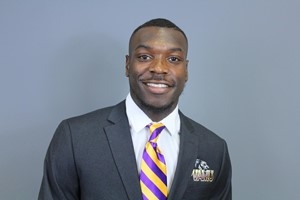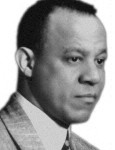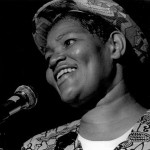A Denver sculptor was the first black man trained as an astronaut ahead of Apollo 11, but he never made it to space
Photo: Ed Dwight, Jr. poses for a portrait in his workspace at his studio in Denver. (Kelsey Brunner, The Denver Post)
A new PBS mini-series profiles Ed Dwight Jr. and other aerospace pioneers
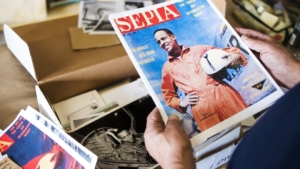
Ed Dwight, Jr. holds images and news clips that he saved from his time as an astronaut in his studio in Denver. (Photo by Kelsey Brunner/The Denver Post)
(The Denver Post) As July lengthens, the flood of ads for TV series, films and events commemorating the 50th anniversary of the July 20, 1969, Apollo 11 moon landing has hit a high mark. Through grainy footage of slow-motion rocket launches and high-definition interviews, they tell a familiar but thrilling tale of America’s nascent steps off the planet.
Most look crisp and compelling, offering a vital history lesson during a time when America could desperately use something to unite around and celebrate.
But most don’t have Ed Dwight Jr.
“My first thought was, ‘Why the hell are they including me in this?’ ” Dwight, a Denver-based sculptor, said of the new PBS series “Chasing the moon,” which premieres July 8-10 on Rocky Mountain PBS, KRMA-Channel 6. “But then I realized it had everything to do with what led up to it.”
Dwight has worked for decades as a sculptor, earning an international reputation with more than one hundred public dedications and thousands of private commissions and sales. His work can be seen at national parks, monuments, sports stadiums and galleries in Denver and around the world, having depicted everyone from President Barack Obama to slain Denver Broncos player Darrent Williams and America’s oft-forgotten black pioneers.
But the 85-year-old’s artistic success obscures an important piece of aerospace history. (more)
Related: One of Ed Dwight’s sculptures is the Texas African-American History Memorial on the grounds of the state capitol in Austin.
A Last Look at Ebony’s Archives, Before They’re Sold
The most significant collection of photographs depicting African-American life in the 20th century is being auctioned. Historians fear the archive could end up hidden away.
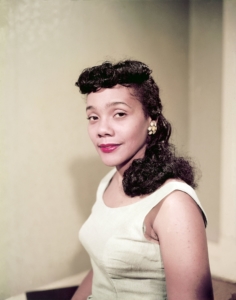
Coretta Scott King, the civil rights activist, in 1958. (Credit: Moneta Sleet Jr./Johnson Publishing Company)
(The New York Times) For months, a stream of visitors — curious, cultured and deep-pocketed — have slipped into a drab brick warehouse on the West Side of Chicago. They have been escorted upstairs in a creaky elevator to a windowless room and handed blue gloves to wear.
Then they have lingered for hours or days over the most significant collection of photographs depicting African-American life in the 20th century.
In one folder, there is Coretta Scott King, cradling her daughter Bernice from a pew at the Rev. Dr. Martin Luther King Jr.’s funeral. In another, Billie Holiday stands on a city sidewalk with a cigarette and a faraway expression. One box holds a black-and-white print of Ray Charles hanging out with a Chicago nightclub owner and playing dominoes, as the typewritten caption noted, “by feel.”
This week, one of the visitors to the warehouse could walk away with it all: the entire photo archive from Ebony and Jet, the iconic sister magazines. The collection of photographs, more than four million prints and negatives, will be offered at an auction on Wednesday conducted privately at a law firm downtown. (more)
Children’s Literature
“Sing a Song”
How Lift Every Voice and Sing Inspired Generations
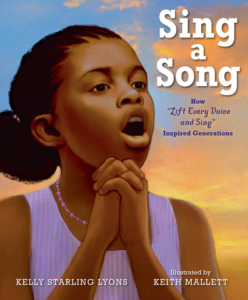 Just in time for the 120th anniversary of the song “Lift Every Voice and Sing”–this stirring book celebrates the Black National Anthem and how it inspired five generations of a family.
Just in time for the 120th anniversary of the song “Lift Every Voice and Sing”–this stirring book celebrates the Black National Anthem and how it inspired five generations of a family.
Sing a song full of the faith that the dark past has taught us.
Sing a song full of the hope that the present has brought us.
In 1900, in Jacksonville, Florida, two brothers, one of them the principal of a segregated, all-black school, wrote the song “Lift Every Voice and Sing” so his students could sing it for a tribute to Abraham Lincoln’s birthday. From that moment on, the song has provided inspiration and solace for generations of Black families. Mothers and fathers passed it on to their children who sang it to their children and grandchildren. It has been sung during major moments of the Civil Rights Movement and at family gatherings and college graduations.
Inspired by this song’s enduring significance, Kelly Starling Lyons and Keith Mallett tell a story about the generations of families who gained hope and strength from the song’s inspiring words.
“There are plenty of picture-book editions illustrating James Weldon Johnson’s text of ‘Lift Every Voice and Sing,’ but the song’s historical impact is often relegated to an afterword. Lyons makes that impact the focus of this narrative. . . . Lyons deftly weaves the song into the family’s everyday life while also using that quotidian existence to emblematize historical experiences. . . . Her storytelling cadence makes rewarding use of repetition, emphasizing the generational replication and adding a lyrical lilt to the prose. . . . This may open youngsters’ eyes to the personal side of history and prompt some sharing by the adults in their lives.”—The Bulletin of the Center for Children’s Books. (more)
SWAC Releases 2019 Preseason All-SWAC Football Teams and Predicted Order of Finish
Several PVAMU players receive honors
Southern University (West) and Alcorn State (East) are the teams to beat in their respective divisions, according to a preseason coaches and media poll for the 2019 Southwestern Athletic Conference football season. The Prairie View Panthers, coming off a 5-6 2018 season in which they finished with a 4-3 conference record are predicted to finish this season second to defending SWAC champion Alcorn.
Eight Panthers were named to the All-SWAC first and second teams, including defensive back Ju’Anthony Parker and wide receiver Tristen Wallace. The PV season opens Aug. 31 in Houston against traditional rival Texas Southern in the 35th edition of the Labor Day Classic at BBVA Stadium.
“Being selected second kind of put’s you in the middle,” said PV Head Coach Eric Dooley. “The thing is I’m not worried about the selection, and hats off to those who believe we will finish second. So it’s up to us to go out and accomplish our goals and that’s what we have to do.” (more)
TIPHC Bookshelf
 Published scholarship on black history in Texas is growing and we’d like to share with you some suggested readings, both current and past, from some of the preeminent history scholars in Texas and beyond. We invite you to take a look at our bookshelf page – including a featured selection – and check back as the list grows. A different selection will be featured each week. We welcome suggestions and reviews. This week, we offer, “Civil Rights in the Texas Borderlands, Dr. Lawrence A. Nixon and Black Activism,” by Will Guzman.
Published scholarship on black history in Texas is growing and we’d like to share with you some suggested readings, both current and past, from some of the preeminent history scholars in Texas and beyond. We invite you to take a look at our bookshelf page – including a featured selection – and check back as the list grows. A different selection will be featured each week. We welcome suggestions and reviews. This week, we offer, “Civil Rights in the Texas Borderlands, Dr. Lawrence A. Nixon and Black Activism,” by Will Guzman.
C. Calvin Smith Award, Southern Conference on African American Studies (SCAASI), 2016
The struggle against racial injustice in the American Southwest
Physician Lawrence A. Nixon fled the racial violence of central Texas to settle in the border town of El Paso. There he became a community and civil rights leader, working on integration and antilynching cases and cofounding the local NAACP chapter. In 1923, Nixon challenged the law that banned African Americans from voting in the Democratic primary. His victory in two subsequent Supreme Court decisions paved the way for dismantling all-white primaries across the South.
Will Guzmán delves into Nixon’s lifelong, and mostly unknown, struggle against Jim Crow. Linking Nixon’s successful activism to his independence from the white economy, support from the NAACP, and indefatigable courage, Guzmán places Nixon within the context of the larger historical narratives of his era. At the same time, he sheds light on Nixon’s presence in both symbolic and literal borderlands–as an educated professional in a time when few went to college, as someone who made waves when most feared violent reprisal, and as an African American living on the mythical American frontier as well as an international boundary.
Enlightening and powerful, Civil Rights in the Texas Borderlands adds to the growing literature on African Americans in the Southwest while exploring a seldom-studied corner of the Black past and the civil rights movement.
This Week in Texas Black History
Jul 22
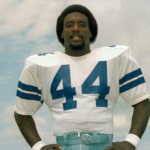 On this day in 2014, Dallas Cowboys‘ great Robert Newhouse passed away from heart disease. Newhouse suffered a stroke in 2010 and had been under treatment at the Mayo Clinic in Rochester, Minn. where he passed away. Newhouse starred at Galilee High School in Hallsville, situated between Longview and Marshall. The University of Houston was the only major school recruiting offer he received and with the Cougars, from 1969-1971, Newhouse set several rushing records and left the school as its all-time single-season rushing leader with 1,757 yards as a senior. That total, at the time, was the second most rushing yards in a season in NCAA history and earned Newhouse second team All-American honors. He was a second round draft pick by the Cowboys in 1972 and played all of his 12 NFLseasons with Dallas. Newhouse led the team in rushing with 930 yards in 1975.
On this day in 2014, Dallas Cowboys‘ great Robert Newhouse passed away from heart disease. Newhouse suffered a stroke in 2010 and had been under treatment at the Mayo Clinic in Rochester, Minn. where he passed away. Newhouse starred at Galilee High School in Hallsville, situated between Longview and Marshall. The University of Houston was the only major school recruiting offer he received and with the Cougars, from 1969-1971, Newhouse set several rushing records and left the school as its all-time single-season rushing leader with 1,757 yards as a senior. That total, at the time, was the second most rushing yards in a season in NCAA history and earned Newhouse second team All-American honors. He was a second round draft pick by the Cowboys in 1972 and played all of his 12 NFLseasons with Dallas. Newhouse led the team in rushing with 930 yards in 1975.
Jul 22
On this day in 1944, Dr. Lawrence Nixon, an El Paso physician, voted in the Democratic primary, the first black voter in the state to do so. The Texas legislature had passed a law in 1923 forbidding blacks from voting in the primary. However, Nixon, working with the NAACP, challenged the law and attempted to vote on July 26, 1924 and was refused a ballot. Twice the U.S. Supreme Court ruled in his favor, however, the state Democratic Partyfound legal loopholes (including asserting the party was a private organization and could set restrictions on who could vote) to continue preventing blacks from voting in the primary. Finally, as a result of the Court’s ruling in Smith v. Allwright (where Lonnie Smith had brought a similar suit in Harris County), the all-white primary was ended on April 3, 1944 enabling blacks to vote in the primary. The Court ruled that a primary was an election and a political party was an agency of the state and thus could not discriminate by race.
Jul 25
Willie Mae “Big Mama” Thornton, blues singer, died of a heart attack at age 57 on this day in 1984 in a Los Angeles boarding house. Thornton grew up in Montgomery, Ala., but settled in Houston where she started her recording career after being discovered by singer and producer Johnny Otis and working with Houston music mogul Don Robey’s Peacock Records. By the time of Thornton’s death, Otis had become a pastor and in that capacity officiated Thornton’s funeral as many musical artists paid tribute. She was buried in Inglewood Park Cemetery in Los Angeles. Later that year, she was inducted into the Blues Foundation Hall of Fame. Thornton’s 1953 hit, “Hound Dog,” was No. 1 for seven of its 14 weeks on Billboard’s R&B charts. Elvis Presley made it an even bigger hit, and Janis Joplin popularized Thornton’s “Ball and Chain.”
Blog: Ron Goodwin, Ph.D., author, PVAMU history professor
Ron Goodwin is an assistant professor of history at Prairie View A&M University. Even though he was a military “brat,” he still considers San Antonio home. Like his father and brother, Ron joined the U.S. Air Force and while enlisted received his undergraduate degree from Texas Lutheran University in Seguin, Texas. After his honorable discharge, he completed graduate degrees from Texas Southern University. Goodwin’s book, Blacks in Houston, is a pictorial history of Houston’s black community. His most recent book, Remembering the Days of Sorrow, examines the institution of slavery in Texas from the perspective of the New Deal’s Slave Narratives.
Recent Posts
A community under siege: the Summer of 1919
One hundred years ago this country basked in the light of victory over fascism, that political system which seemingly posed a direct threat to the ideals of democracy. Supposedly, citizens in a democratic society would be able to advance socially and economically as far as their talents would take them. I guess the operative word is “citizen”…(more)
Death is nothing at all
“Therefore we are always confident, knowing that, whilst we are at home in the body, we are absent from the Lord: (For we walk by faith, not by sight:). We are confident, I say, and willing rather to be absent from the body, and to be present with the Lord.” 2 Cor 5: 6-8. As a child my father and I would watch “Hogan’s Heroes.” It’s a silly sitcom, but I remember how I enjoyed…(more)
Submissions wanted
Historians, scholars, students, lend us your…writings. Help us produce the most comprehensive documentation ever undertaken for the African American experience in Texas. We encourage you to contribute items about people, places, events, issues, politics/legislation, sports, entertainment, religion, etc., as general entries or essays. Our documentation is wide-ranging and diverse, and you may research and write about the subject of your interest or, to start, please consult our list of suggested biographical entries and see submission guidelines. However, all topics must be approved by TIPHC editors before beginning your research/writing.
We welcome your questions or comments. Please contact Michael Hurd, Director of TIPHC, at mdhurd@pvamu.edu.

